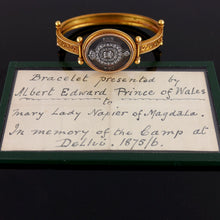Prince of Wales’s Indian Tour - A Royal Presentation Bracelet, 1875-76
- Regular price
- £7,500
- Sale price
- £7,500
- Regular price
-
- Unit price
- /per
Adding product to your cart
Provenance: Mary, Lady Napier of Magdala, second wife of Field Marshal Robert Cornelis Napier, 1st Baron Napier of Magdala.
Gold and silver. Bracelet in the Archaeological Revival style with bead and wire decoration, containing the Prince of Wales presentation medal for his tour of India 1875-76. Obverse: Prince of Wales' plumes within Garter and the chain of the order of the Star of India, dividing A - E Reverse: H. R. H. / ALBERT EDWARD / PRINCE / OF WALES / INDIA / 1875-6. The bracelet with hinged lower half and pin clasp. Medal: 24mm x 21mm. Gross weight 21.66g. Complete with a manuscript note inscribed ‘Bracelet presented by / Albert Edward Prince of Wales / to / Mary Lady Napier of Magdala / In memory of the Camp at / Delhi. 1875/76.’ Cased.
In October 1875, Albert Edward Prince of Wales, the eldest son of Queen Victoria and future Edward VII (reigned 1901-1910), embarked on an extensive tour of the Indian subcontinent to herald Queen Victoria's accession as Empress of India. On landing at Bombay on 8 November 1875, the Prince accompanied by the Viceroy of India, and his suite was received by Lord Napier of Magdala, then Commander-in-Chief in India, together with high civil and military officials, upwards of seventy native princes, chiefs, and sirdars and ‘a dense seething mass of people of all classes who occupied every inch of standing room from the ground to the house tops computed to have numbered nearly 200,000.’ Over the course of the next six months the Lord and Lady Napier were frequently in attendance on the Prince as he visited more than 21 towns and cities before returning to England in May 1876.
Read more
After visits to the Cawnpore and Lucknow to commemorate British and Indian sacrifices made during the Indian Mutiny of 1857, the royal entourage travelled overnight by train, to reach Delhi on 11 January 1876, where they spent six days. There was the usual tremendous welcome, and again the visit was imbued with memories of 1857: most of the activities during the stay were of a military nature. As they had done at Benares, the guests stayed under canvas, and again in considerable luxury. The Prince's tents in particular were splendidly appointed: ‘The camp was a more luxurious bivouac than any monarch sleeping in the tented field has ever enjoyed’ reported George Wheeler of ‘Central News’. There was a levee, followed by a glittering review of both British and Indian regiments, with the Prince sporting the uniform of a Field Marshal, and extensive military manoeuvres, with the Prince himself taking part on a charger.
Of the extensive exchange of gifts both to and from the Prince of Wales, it is noted ‘The Prince presented commemorative gold and silver medals, bracelets, rings, lockets and watches commissioned from the crown jeweller, Garrard and Co., and presentation rifles, swords and daggers from Purdey and Sons and the Wilkinson Sword Company.’
Field Marshal Robert Cornelis Napier, 1st Baron Napier of Magdala GCB, GCSI, FRS, (1810-1890) was a British Indian Army officer. He fought in the First Anglo-Sikh War and the Second Anglo-Sikh War before seeing action as chief engineer during the second relief of Lucknow in March 1858 during the Indian Rebellion of 1857. He also served in the Second Opium War as commander of the 2nd division of the expeditionary force which took part in the Battle of Taku Forts, the surrender of Peking's Anting Gate and the entry to Peking in 1860. He subsequently led the punitive expedition to Abyssinia July 1867, defeating the Emperor Tewodros II of Ethiopia with minimal loss of life among his own forces and rescuing the hostages of Tewodros. Napier became Commander-in-Chief, India, with the local rank of full general in April 1870, and having been promoted to the substantive rank of full general on 1 April 1874,[26] he became Governor of Gibraltar in June 1876. In April 1861 he married Maria Cecilia Smythe Scott as his second wife: they had six sons and three daughters.












